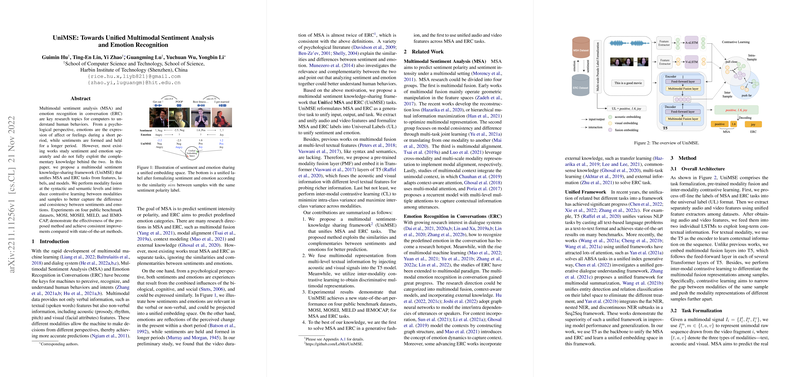Unified Multimodal Sentiment Analysis and Emotion Recognition: An Expert Overview
The paper introduces UniMSE, a novel framework designed to bridge the gap in current research by unifying multimodal sentiment analysis (MSA) and emotion recognition in conversation (ERC). Traditionally, these two areas have been treated as distinct, despite their underlying similarities and potential for complementary insights. UniMSE addresses this by employing a unified approach that merges features, labels, and models to exploit the shared knowledge between sentiment and emotion.
Framework Overview and Methodology
UniMSE proposes a multimodal sentiment knowledge-sharing framework that leverages advanced techniques in deep learning, particularly pre-trained models and contrastive learning. A critical advantage of UniMSE is its capacity to integrate both syntactic and semantic modal fusion, synthesizing data from text, audio, and visual inputs. This fusion is further enhanced by contrastive learning, which refines the model's ability to distinguish between sentiments and emotions by maximizing the inter-class variance.
The implementation of UniMSE involves several key components:
- Task Formalization: This process involves reformulating MSA and ERC into a generative task framework using universal labels (UL). These labels harmonize sentiment and emotion data inputs into a cohesive format, making them comparable and compatible within the same model.
- Pre-trained Modality Fusion (PMF): By embedding multimodal fusion layers within the Transformer architecture of T5, PMF allows the model to leverage multilevel textual features alongside acoustic and visual data. This novel integration exploits the rich text nonlinearities captured by pre-trained models, enhancing the comprehensiveness of sentiment and emotion representations.
- Inter-modality Contrastive Learning: This introduces a contrastive loss function that operates between different modal representations, promoting consistency across similar sentiment and emotion samples while ensuring distinct representations for different classes. This process is vital for improving discriminative capabilities across multiple modalities.
Experimental Results
The framework's efficacy was rigorously evaluated across four benchmark datasets: MOSI, MOSEI, MELD, and IEMOCAP. The experimental results indicate that UniMSE surpasses current state-of-the-art models on several key performance metrics. For example, UniMSE demonstrates substantial improvements in binary classification accuracy and F1 scores, achieving a new standard in both MSA and ERC tasks.
Theoretical and Practical Implications
The findings from UniMSE indicate significant implications for both the theoretical understanding and practical applications of sentiment and emotional AI systems. Theoretically, the unification of sentiment and emotion into a single framework challenges the convention of treating these processes separately, offering a compelling argument for their inherent complementarity. Practically, UniMSE's improved accuracy and nuanced multi-modal integration provide a robust platform for deploying more sophisticated AI solutions in fields such as customer service, mental health analysis, and social media analytics.
Future Directions
Looking forward, the UniMSE framework opens several avenues for further research. One potential direction involves the expansion into additional modalities, including physiological signals, to enrich the sentiment-emotion fusion. Moreover, advancing the contrastive learning mechanisms could close any identified gaps in inter-class differentiation for granular sentiment-emotion categorizations.
In conclusion, UniMSE marks a significant advancement in the pursuit of integrated sentiment and emotion recognition systems. By exploiting multimodal synergies, the framework promises enhanced modeling capabilities, potentially transforming how machines understand human emotion and sentiment dynamics.
